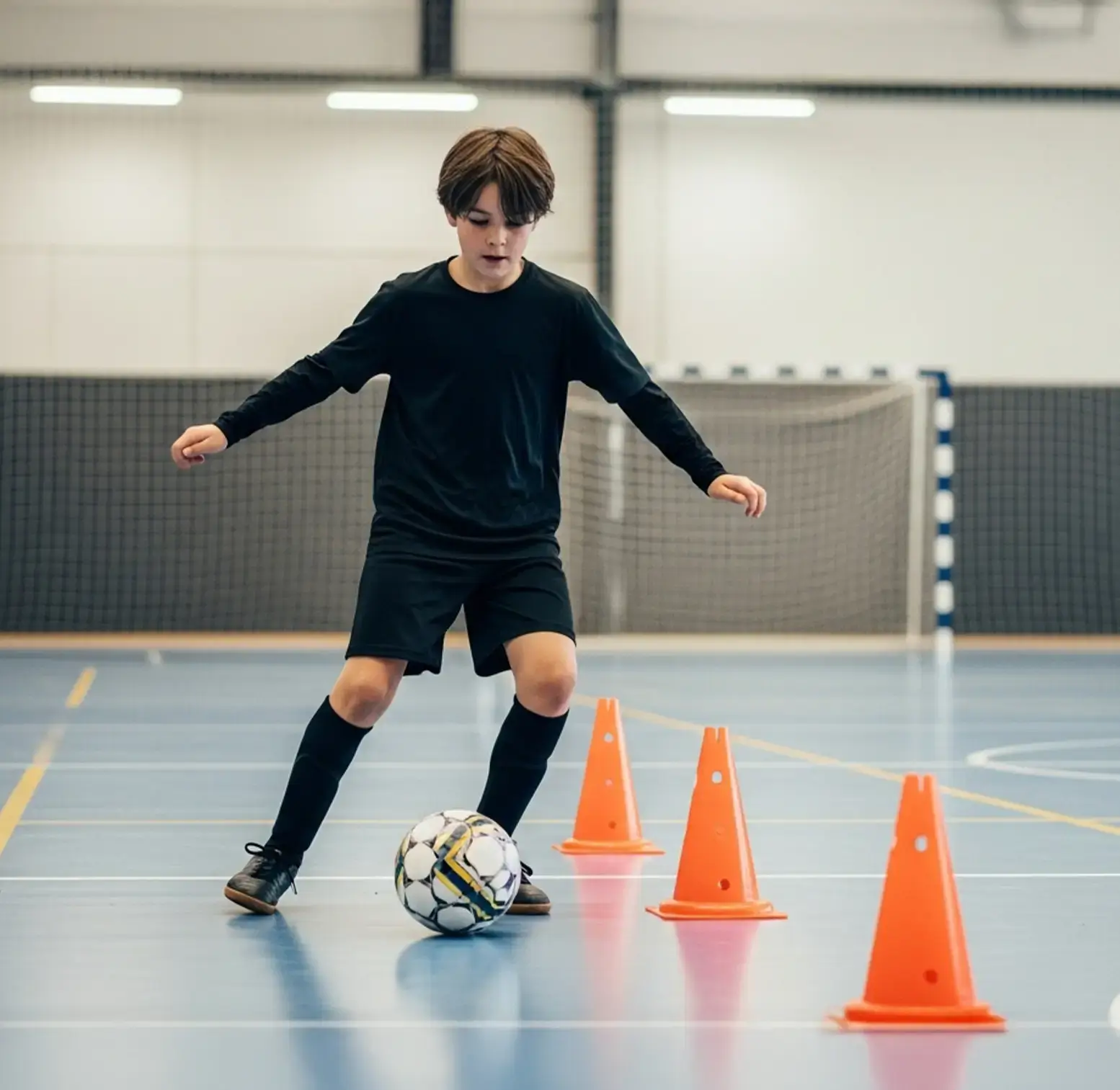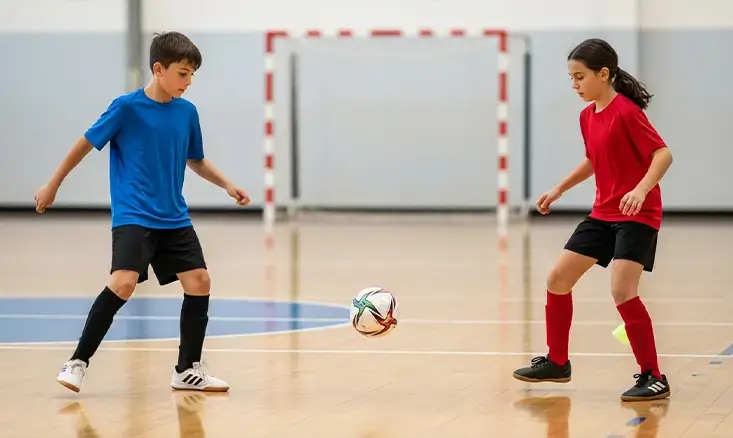10 Futsal Training Drills for Beginners to Improve Your Game

CRFC BLOGS
LATEST BLOGS & NEWSLETTERS
10 Futsal Training Drills for Beginners to Improve Your Game
Looking to sharpen your control, quickness, and creativity on the ball? Futsal offers the perfect environment for young players to improve quickly. In tight spaces, every touch matters, and repetition builds confidence. These 10 fun, easy-to-follow futsal drills will help beginners develop balance, awareness, and decision-making one step at a time.
1. Wall Pass Challenge
Every great player starts with consistency. The Wall Pass Challenge trains both feet while improving first touch and passing accuracy. It sets the rhythm for all ball control work that follows.
How to do it:
- Stand five feet from a wall or rebounder.
- Pass, control, and return with one touch.
- Alternate between left and right foot.
- Move laterally between passes to simulate in-game positioning.
This drill builds the foundation for reactive play. When players master passing tempo, they’re ready to develop faster, softer touches with rhythm-focused drills.

2. Toe-Tap Rhythm Drill
Once control improves, players need agility. The Toe-Tap Rhythm Drill develops coordination, stamina, and balance, core traits in futsal, where the ball is always close.
How to do it:
- Tap the top of the ball lightly with alternating feet.
- Stay light on your toes and maintain a steady beat.
- Start with 30-second rounds, rest, then increase time each set.
It’s simple but powerful. As foot speed improves, players naturally move into more dynamic dribbling patterns, preparing for directional control and cone-based movement.
3. Cone Weave Dribble
Futsal rewards players who can maneuver through tight spaces. The Cone Weave teaches control, precision, and body balance, three essentials in any small-sided match.
How to do it:
- Set up 5–6 cones in a straight line, spaced about two feet apart.
- Dribble through using both feet and inside/outside touches.
- Keep the ball close; speed comes after control.
This drill connects to game reality—navigating defenders in traffic. When a player can glide through cones cleanly, they’re ready to learn how to change direction and control tempo with advanced movements.

4. The “V” Move Mastery
Direction changes define strong futsal players. The “V” move helps beginners learn how to protect the ball while shifting pace to escape defenders.
How to do it:
- Pull the ball back diagonally using the sole of one foot.
- Push it forward at a new angle with the other foot, forming a “V.”
- Repeat continuously on both sides for 60 seconds.
This move combines control and deception, skills that build confidence in one-on-one situations. It’s a natural bridge to live attacking and defensive drills.
5. 1v1 Mini Battles
Now it’s time to apply individual control in game-like situations. Small 1v1 drills teach spacing, quick decision-making, and anticipation.
How to do it:
- Set up a 5×5-yard grid.
- One player attacks, one defends for 30 seconds.
- Reset, switch roles, and repeat several rounds.
These mini-battles develop composure under pressure. Players learn when to dribble, pass, or protect the ball—a vital skill set for real matches.

6. Pass-and-Move Squares
After mastering solo skills, players must learn how to combine movement and teamwork. This drill focuses on awareness and communication, futsal’s most overlooked skills.
How to do it:
- Create a small square (about five yards per side).
- Players pass and follow their pass to the next cone.
- Add a one-touch rule as accuracy improves.
Pass-and-move habits make teams flow smoothly. Young players begin recognizing angles and anticipating teammates’ movement, a key part of smart futsal play.
7. Quick Turns Drill
Futsal is full of rapid direction changes. This drill strengthens balance, control, and acceleration after turns.
How to do it:
- Place two cones five yards apart.
- Dribble from one to the other, perform a turn (drag-back, inside cut, outside cut), and return.
- Keep sessions short and intense, about 60 seconds each.
It’s a great way to teach players body control and quick restarts, mimicking how the ball changes direction during real matches.

8. Gate Passing Challenge
Precision matters more than power in futsal. The Gate Passing drill develops accuracy and composure in tight lanes.
How to do it:
- Set up small “gates” using two cones a yard apart.
- Pass through from 5–10 yards away.
- Track successful passes within 60 seconds.
Players who learn to pass accurately under light pressure transition smoothly into combination play, where accuracy creates scoring chances.
9. Shadow Dribbling
Awareness separates good players from great ones. Shadow Dribbling trains players to read movement, react fast, and maintain control while observing others.
How to do it:
- Pair up players. One leads, the other mirrors movements while dribbling.
- Include feints, direction changes, and tempo shifts.
- Switch roles after a minute.
This exercise improves visual awareness and rhythm, encouraging players to read the game rather than just chase the ball.

10. 4-Corner Passing Rotation
To tie everything together, the 4-Corner Passing Rotation blends teamwork, communication, and endurance. It’s a smooth finale that mirrors real futsal transitions.
How to do it:
- Set four cones in a large square, about 10 yards apart.
- Pass around the square while sprinting to the next cone.
- Keep the tempo consistent, adding a second ball for difficulty.
This builds rhythm, stamina, and timing—showing how all the earlier skills (control, passing, decision-making) connect in fluid team movement.
Why These Drills Work
Each drill builds on the last, helping beginners progress naturally from control to creativity. Players start grounded—learning balance and coordination—then move toward quick decisions and confident teamwork.
Futsal’s smaller space means constant engagement and faster improvement. That’s why clubs like Charlotte Rise FC use futsal sessions to build player confidence through repetition and fun competition.
It’s not about perfection, it’s about progress through play. When young players feel comfortable on the ball, everything else- speed, teamwork, and love for the game—follows naturally.
FAQs
At what age can kids start futsal training?
Kids can start futsal as early as five. The Rising Stars Program at Charlotte Rise FC welcomes ages 5–12, focusing on confidence, balance, and coordination through fun, age-appropriate drills. Younger players learn movement patterns and teamwork in a safe, energetic setting—skills that build the foundation for long-term soccer growth both indoors and outdoors.
How does futsal help outdoor soccer players?
Futsal’s smaller court and constant ball contact help players develop faster reactions, tighter control, and smarter decisions. It complements outdoor play by improving vision and composure under pressure. Players who train both formats often advance quickly. For more on skill transfer, explore our guide on youth soccer player development and soccer skill improvement.
How often should beginners practice these drills?
Two to three short sessions a week are ideal for beginners. Each session should mix touches, movement, and small-sided games to keep training engaging and effective. Regular repetition builds consistency, while rest days prevent burnout. Parents can use our 4-week ball mastery plan to structure at-home futsal practice around clear, weekly progress goals.
What equipment is needed for futsal training?
Futsal requires minimal gear—just indoor shoes, shin guards, and a smaller low-bounce futsal ball. Because the focus is on control, even simple spaces work for training. Players can supplement futsal drills with techniques from our dribbling guide and passing drills for youth to enhance ball confidence.
Is futsal safe for young players?
Yes. Futsal’s low-contact, indoor format makes it one of the safest ways for kids to develop soccer skills. Its smaller, cushioned surface reduces injuries while boosting coordination. Coaches at Charlotte Rise FC emphasize safety, form, and fun during every session. Parents interested in smart training can read our guide on soccer injury prevention.

Did you find this useful?


